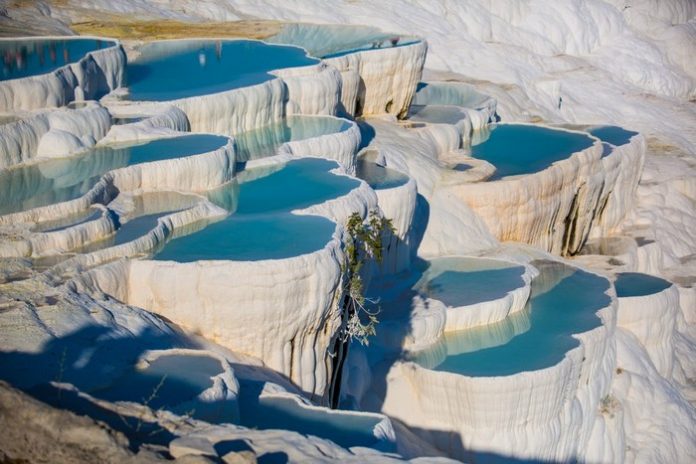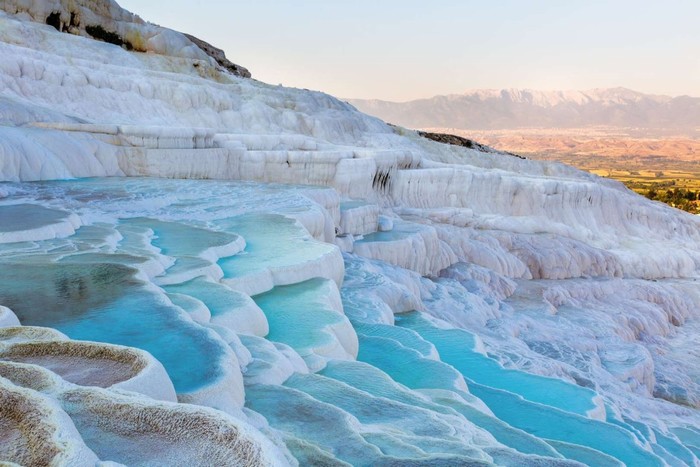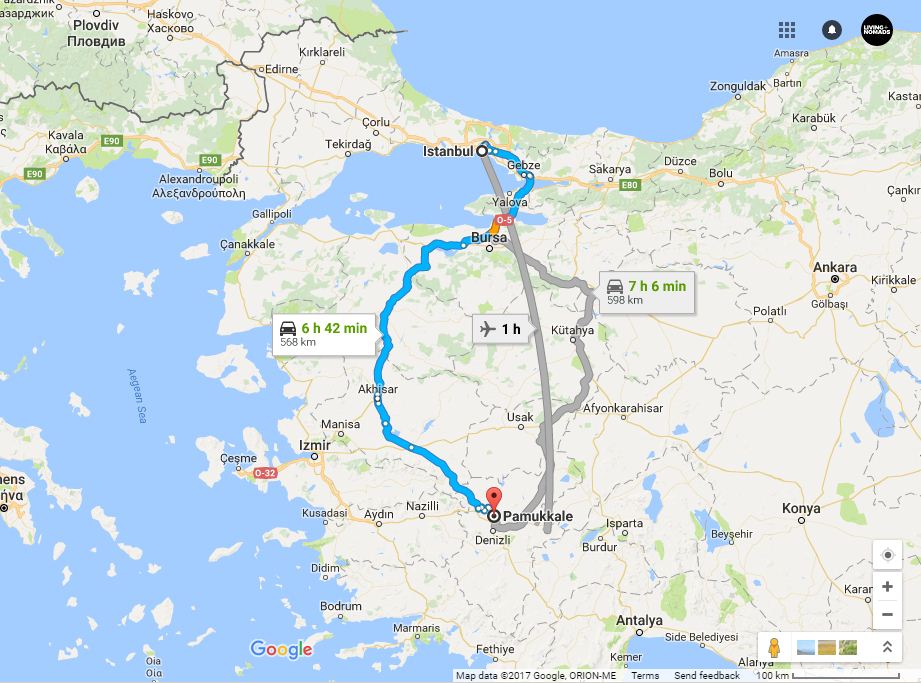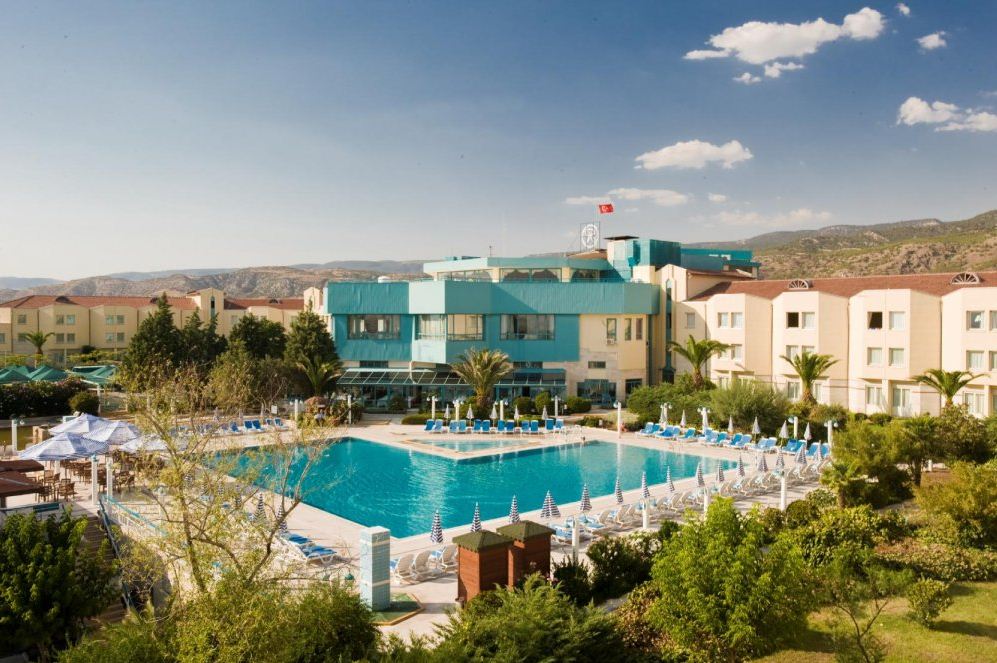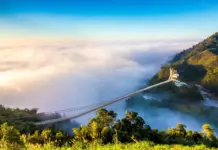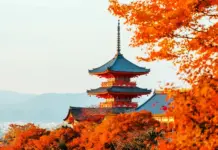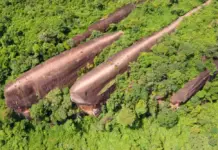Pamukkale is a unique, wonderful, and mind-boggling gift that the Creator has lovingly dedicated to Turkey. Pamukkale shows a gorgeously magical beauty which seems to be so surreal that you may think it’s unreal. But it does exist, for thousands of years. This scenic site promises to take you to a new paradise of water that has long been one of the most wonderful and must-go destinations in Turkey! Let’s go to check out to know how ravishing Pamukkale truly is!
- Where to visit in Queenstown: 15 must see & best places to visit in Queenstown
- 19+ best sightseeing spots & most beautiful places to see in Japan: Mountains – Forests – Seas – Cities
- Hin Sam Wan – Conquering the Famous “Three Whale Rocks” in Bueng Kan
- The ULTIMATE Turkey travel guide: Top attractions, best things to do, Tips Itinerary & MORE
- What to do & where to go in Alishan: 15 top things to do & best places to visit in Alishan, Taiwan

Pamukkale, meaning “cotton castle” in Turkish, is a natural site in Denizli Province in southwestern Turkey, about 650km from Istanbul.The Pamukkale site includes a step-like stack of travertines, or calcium carbonate shelves, filled with warm, milky-blue water. The formation is so striking that UNESCO declared it a World Heritage Site in the 80s. Undergoing the thousand-of-years test of time, Pamukkale never tends to lose a little of its surreal and irresistible beauty where you come to know that you find a heaven of water on earth.
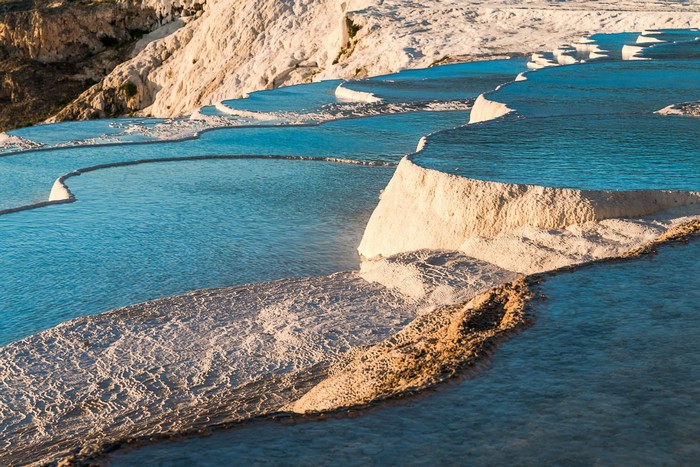
Its one of a kind ultimate majesty remains through years by years by years.
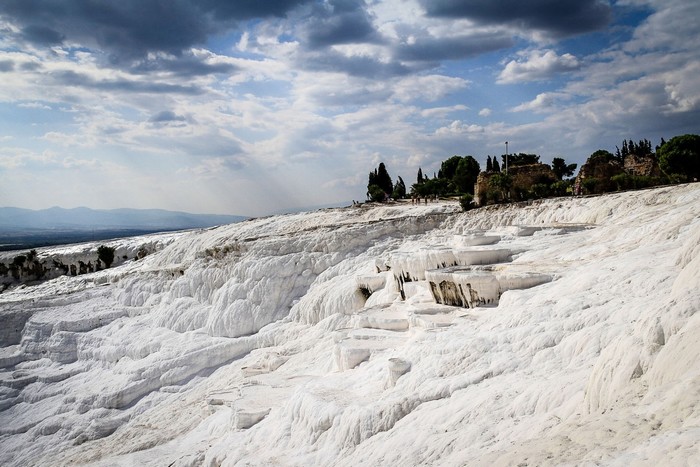
Though the scenery looks like sheets of ice, these white cotton-like terraces are a process that started over a million years ago. The pools are made when naturally occurring hot water bubbles up from under the ground. As it reaches the surface, the water percolates through a layer of limestone, dissolving calcium into the hot water. By the time the water reaches the surface, it is chalky white with dissolved calcium, or more technically calcite, from the limestone.
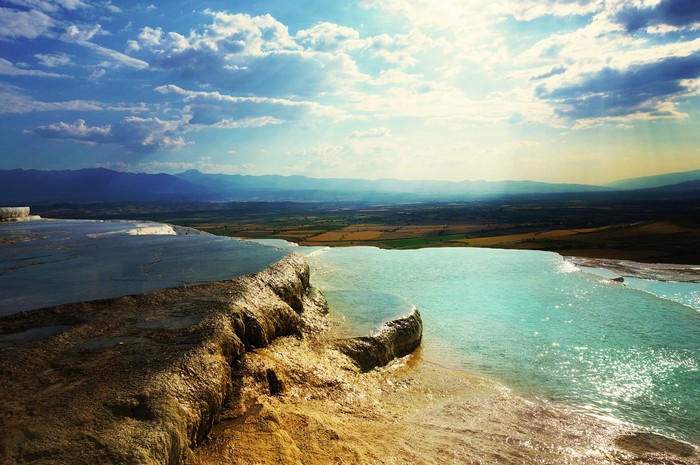
The pools are undoubtedly one of the most extraordinary natural wonders of the world, and is anything but phenomenal.
Understanding the mystery of Pamukkale
There are 17 hot springs in Pamukkale with temperature ranging from 35 degrees to 100 degrees. The water, once emerging from the spring, is then transported 320m to the head of thee terraces where it deposits calcium carbonate. Once the water reaches the surface, carbon dioxide is de-gassed and the result is deposition of calcium carbonate. The deposition continues until the carbon dioxide in the water and in the air is balanced. Calcium carbonate is deposited as a soft jelly, but in the travertine the carbonate hardens.
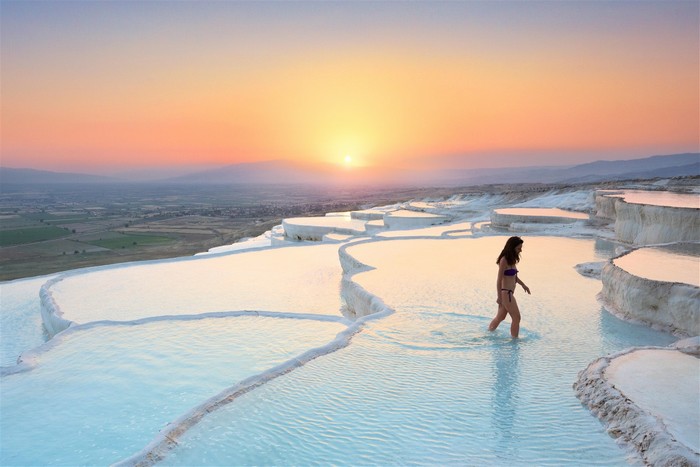
“And it’s insanely gorgeous.” Will be the first thought you make at the first sight of Pamukkale. The Cotton Castle, as it’s known in Turkish, is aptly named and from a distance, its huge white slopes are more reminiscent of snow than rock.
The water temperature of these terraces remains consistent between 95 – 212 degrees Fahrenheit (35-100 degrees Celsius), so guests can comfortably splash around, even in winter. Yeah so great that they’re open all year around!
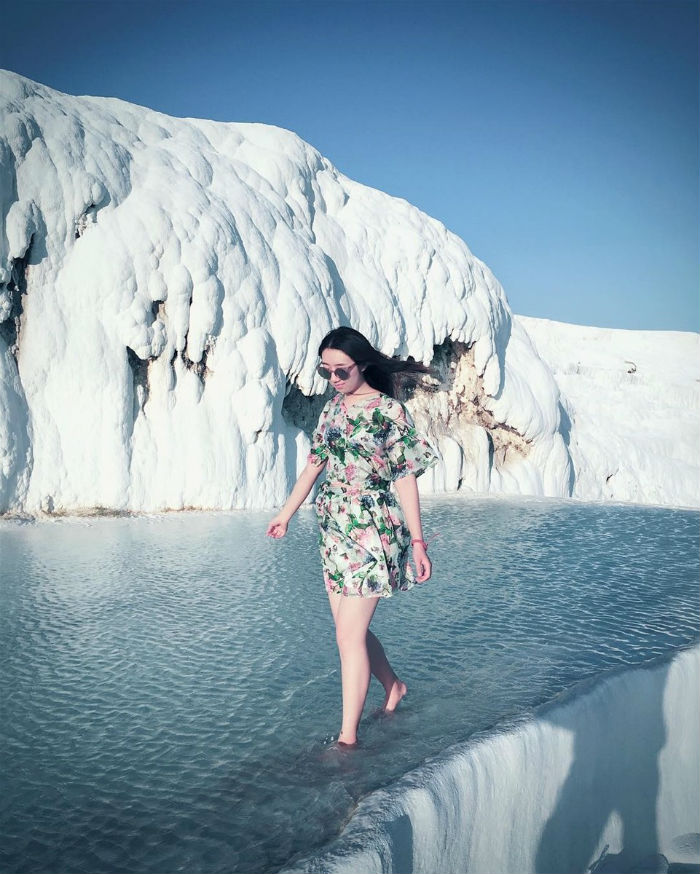
The real charm lies in walking on the terraces of basin. It is really an experience beyond words. Walking on the travertines will give you some weird and slimy feeling to your feet. It feels like chalky gloop, but it is a lot of fun to squish between your toes and fingers. You should try!
History of Pamukkale
Pamukkale means “Cotton Fortress” in old Turkish, but the Turks were certainly not the first to name it. This natural formation of bone-white pools of travertine limestone, formed into a sprawling stack of terraces over the course of geologic ages, has been an operational health spa since Roman times. The Romans, in fact, held the site as sacred, building the small city of Hierapolis around one of Pamukkale’s warm-water springs. The Romans’ sacred pool is still in use, the vestigial marble columns of its temple lining the perimeter.
Health benefits

Pamukkale is considered a natural health spa thanks to the many benefits it provide for its visitors. According to many, the water provides cure against asthma and rheumatism.
Additionally, the water brings benefits to the skin, eyes, helps recover from high blood pressure, kidney stones, stroke, physical exhaustion, circulatory issues, digestive maladies, chronic disorders and nutritional disorders.
Best time to visit Pamukkale is the spring, as the weather and the climate is at a normal level. In the summer, the temperature can go up to 40+ degrees and humidity is another issue.
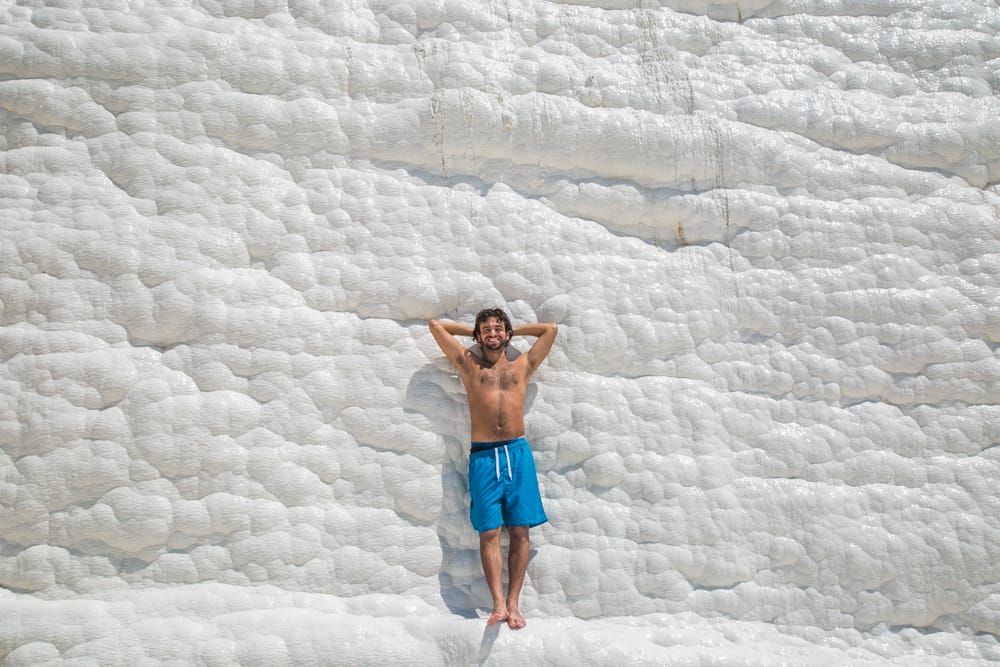
You’ll be expected to carry your shoes most of them if you’re not going to leave them at the top of the summit where many other people would leave their shoes or belonging. It is advisable for you to bring a backpack to carry your shoes while you go barefoot, or just tie up the shoelaces and hand the shoes on your shoes. That is if you’re wearing shoes. You’ll have to figure out if you’re wearing footwear without shoelaces.

As you wander to the edge of the travertine, the gloop of calcium deposits from the bottom of the water has skin benefits if you put it on your skin. So, instead of taking a soothing mud or calcium bath, you can cover yourself with the ooze like a monster. It has a chalky texture when you rub it all over your body.
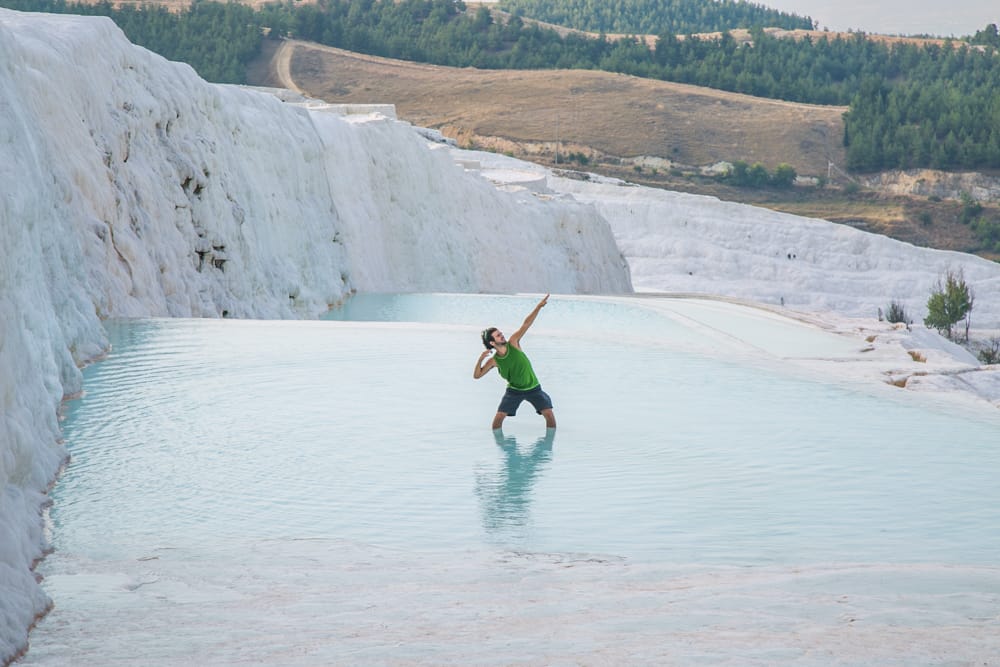
“I was in my own cloud nine when I was in the scenery. The color of the pools was beyond unreal to me. And it’s incredibly beautiful!”Calvin Young shared his own experience in Pamukkale.
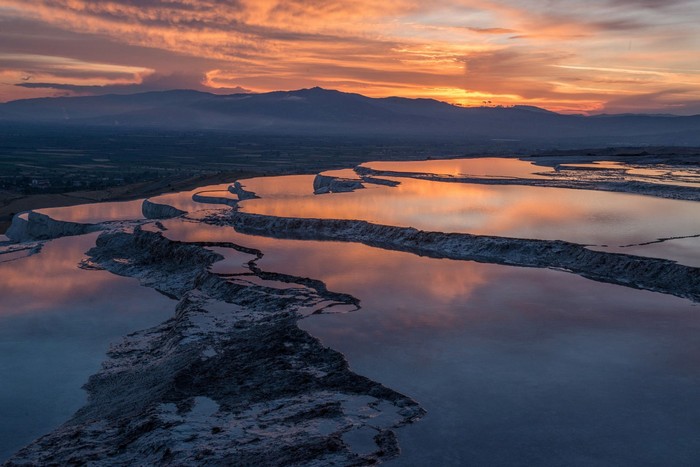
Also, some of the surfaces are a little bit slippery, especially around the edges of the main pools. So you should be careful and watch your steps. Most of the areas without water are not as slippery as the areas near or in the waters, though.
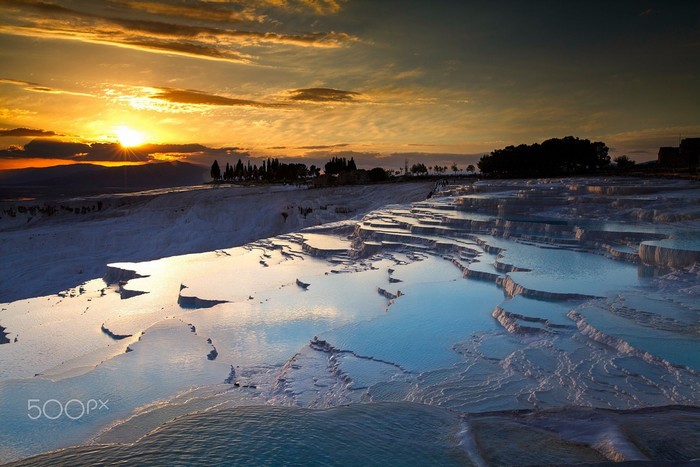
The travertines are very fragile and easily damaged by humans and their footwear. There had been a restricted section at the top of the hill where people couldn’t get on because of the damages that was done to the travertines by the hotels that were once built directly on top of the terraces in the 1980s.
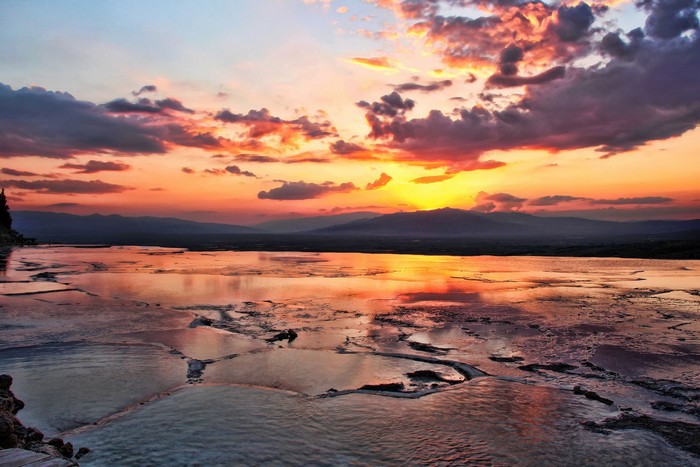
It is one important note is that you should respect and leave no trace of damage to the nature, so others can get the same experience you had. Violating the designated area wouldn’t just ruin the nature of the travertines but it would also ruin the experience of future visitors because they wouldn’t see the same thing as you. Be mindful of the nature and others, so don’t ruin it for others.
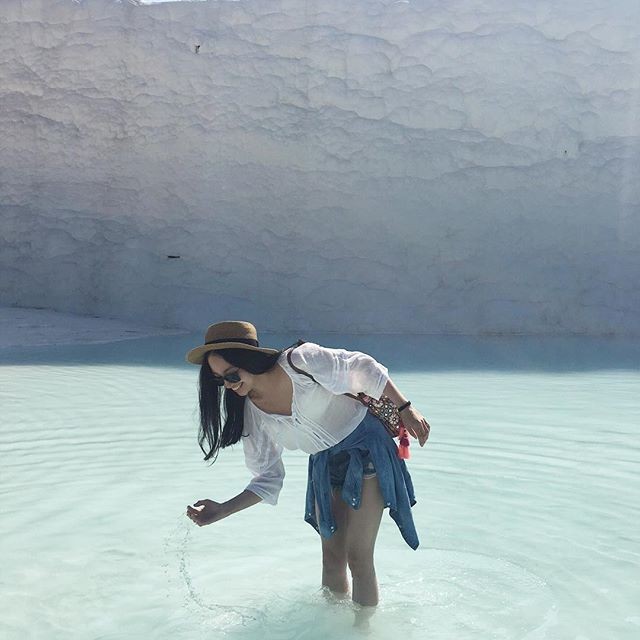
There are two entrances to the Pamukkale travertines. One is at the top at the ancient town of Hierapolis and a less used entrance is at the bottom of the travertines in the town of Pamukkale itself. At the top entrance near the ruins, you can catch beautiful scenery of the pools where people are not allowed to swim in. That’s where the scenic view for photographers. You’d better go there if you’re a photographer and you want to capture beautiful scenery. Truth to be told, you cannot describe how beautiful the view is at the top.
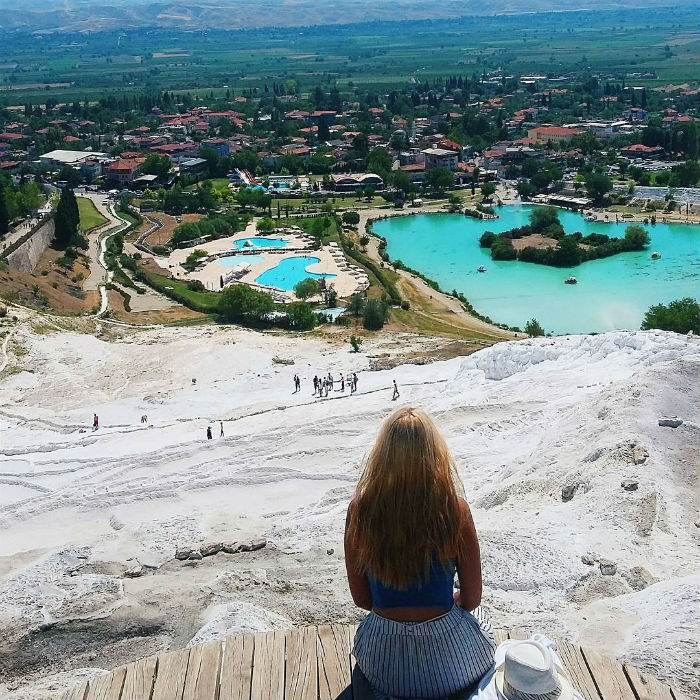
However, this area at the top has visitor’s center where you can sit down and eat while enjoying the scenery. They have cool gift shops as well. As mentioned, you’ll see some of the ruins at the top. Beautiful sight to see! Clearly, this spot is the one most favored by large tour groups, so you’ll encounter most of your fellow tourists there.
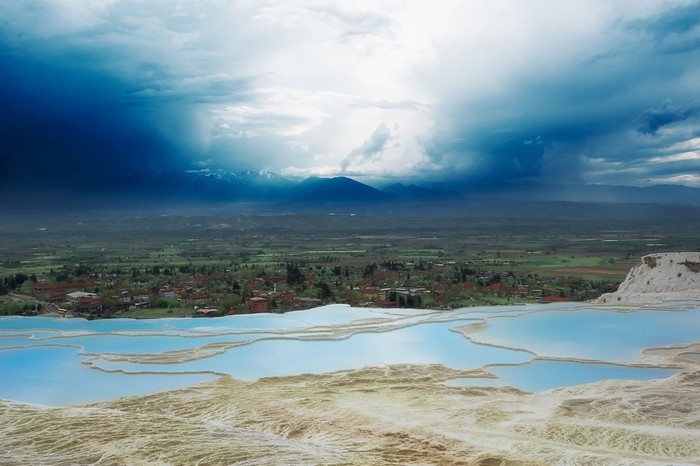
Since the area is at the top, it’s also pretty busy with minibusses and taxis with passengers getting on and off. In the meanwhile, the bottom entrance is just easily accessed without minibus or taxi. You can just walk through, but you can still go up for a long hike to the summit where the Hierapolis is at from the bottom.
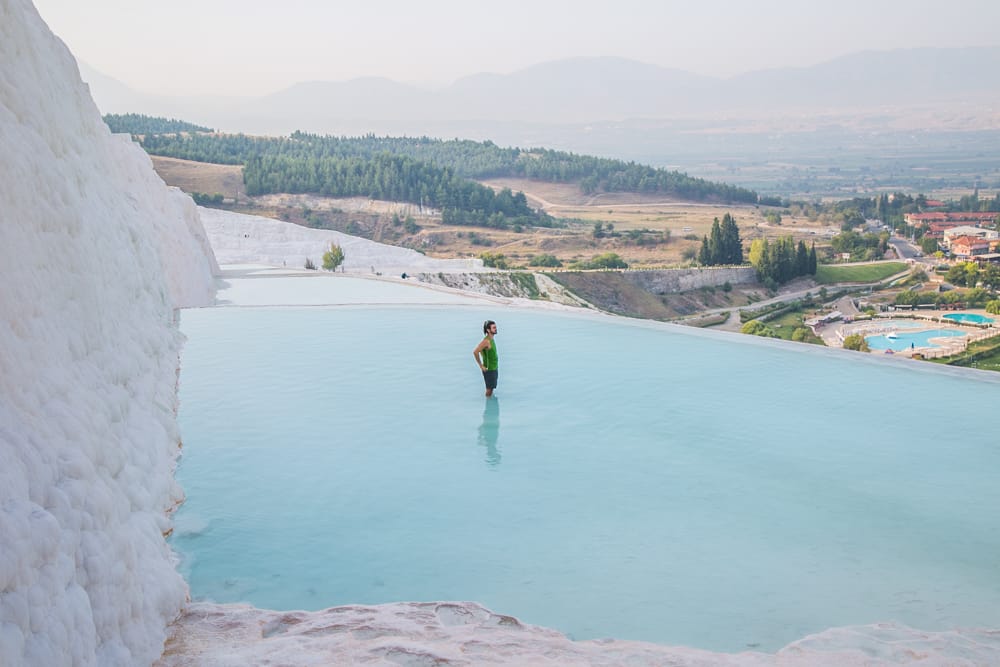
Keep in mind that the waters at the bottom are a bit cooler than the ones at the top. Travertines are also a lot quieter and settled along with fewer tourists. The rocks at the bottom of the pools are whiter. It’d be great for photos, too!
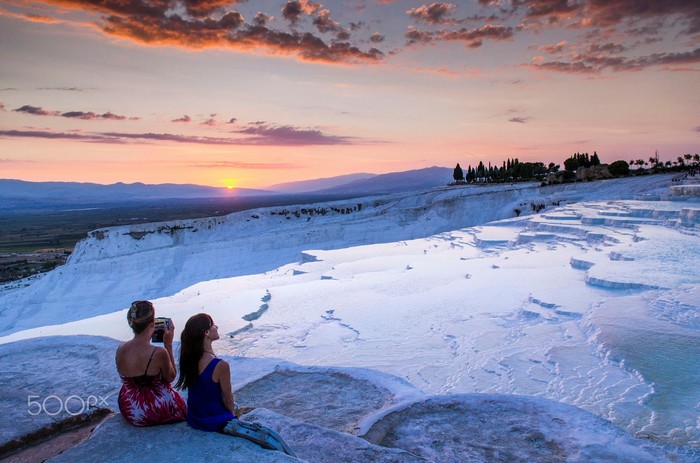
If you want to get the best of the scene, you should go there early in the morning when there aren’t so many tourists. Not only that, you’d be able to catch a beautiful sunrise and take some awesome shots of you and the castle. It’s a long, hot hike to the top of the travertines and Hierapolis, especially in summer. Bring along water, sunscreen, and a hat.
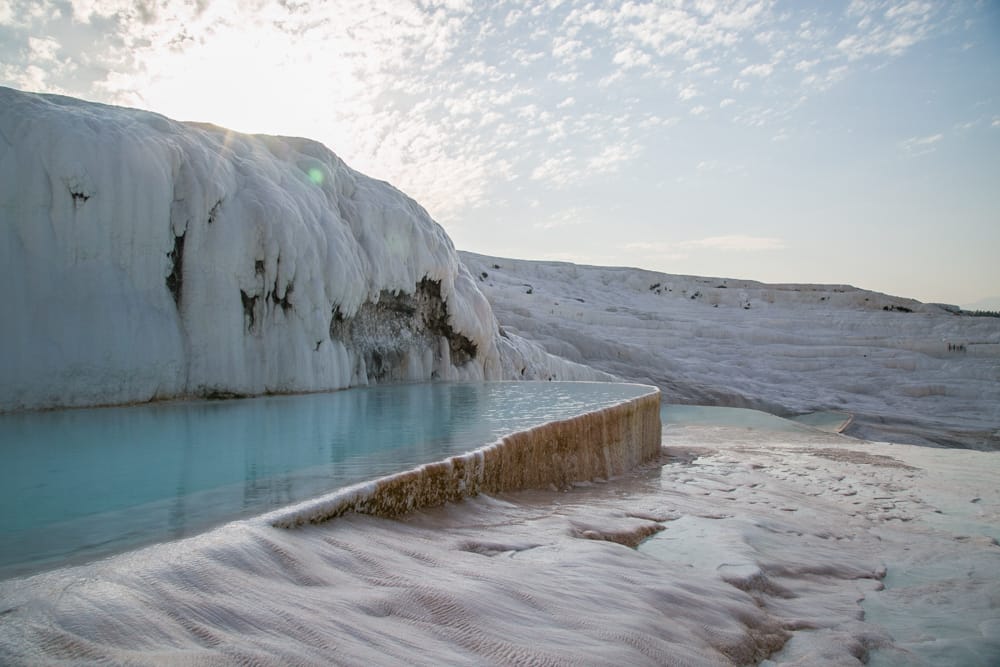
The travertines, with their glowing white natural hot pools terraced along a mountainside, are featured in almost every tourist brochure about Turkey and rightly so. So don’t hesitate to plan a trip to this paradise of water as its beauty is truly beyond our words!
https://www.youtube.com/watch?v=houpSwFn7j4
Further information of Pamukkale:
- Address: 15 Mayıs Mahallesi 554/1 Sk No:5 Denizli, Turkey
- Opening time: 8am–8pm daily (until 5pm in the winter)
- Admission to thermal pools: 40 TL (~$13 US Dollars) — free for the Disability
- Website: pamukkale.gov.tr or pamukkale.net
- Twitter: twitter.com
When to visit Pamukkale Turkey
Pamukkale climate is nice and warm throughout the year. The Aegean and the Mediterranean seas make it a pleasant place to be with sunny summers and warm winters. The therapeutic pools are ideal for a visit with family and friends both.
Anyone visiting in the summer will not be surprised to discover that archaeologists have discovered in Pamukkale a site that matches the ancient Greek description of the Gates of Hell. The Aegean summer heat sears sensitive skin, pricks up migraines and can make visiting the region a distinctly uncomfortable experience. A springtime visit to Pamukkale, undertaken anywhere between April and mid-June, is ideal. In the spring, visitors can expect moderate, dry weather and longer daylight hours. Though Istanbul is packed in the springtime, this represents the off-season for Pamukkale’s regional tourism, which is driven by summertime traffic to beach resorts. If springtime isn’t an option, autumn’s mild weather lasts from mid-September through October. However, daylight hours are shorter than in the spring, and the potential for rain looms more often in the fall.
- Winter: November to Mid-February is the winter season and except for the chilly month of January when the temperature drops below 0 degree Celsius, the winter is also a good time to visit Pamukkale.
- Spring: One of the best seasons to visit Pamukkale is spring which falls between the months of February and April. The temperature is around 20 degree Celsius and the weather in Pamukkale is pleasant for splashing in the hot springs. Also, the beautiful blossoms make it an alluring sight.
- Summer: The summer season is usually hot and the temperature stays between 30 to 40 degree Celsius. Although, being a holiday time, the summer months of May to mid-August in Pamukkale are full with tourists.
- Autumn: The temperature in autumn is considered ideal for visiting Pamukkale. The best months to visit are August, September and October. The month of September is when major festivals in Pamukkale take place making it an ideal month to go to Pamukkale.

Best time of year to visit Pamukkale
One of the best seasons to visit Pamukkale is spring which falls between the months of February and April. The temperature is around 20 degree Celsius and the weather in Pamukkale is pleasant for splashing in the hot springs. Also, the beautiful blossoms make it an alluring sight.
The best time to visit Pamukkale is spring and autumn but can vary with the likes of visitors. If visiting Pamakulle for the first time then go with the spring season months of February to April. Autumn can be considered as the crowds are lesser during this period.
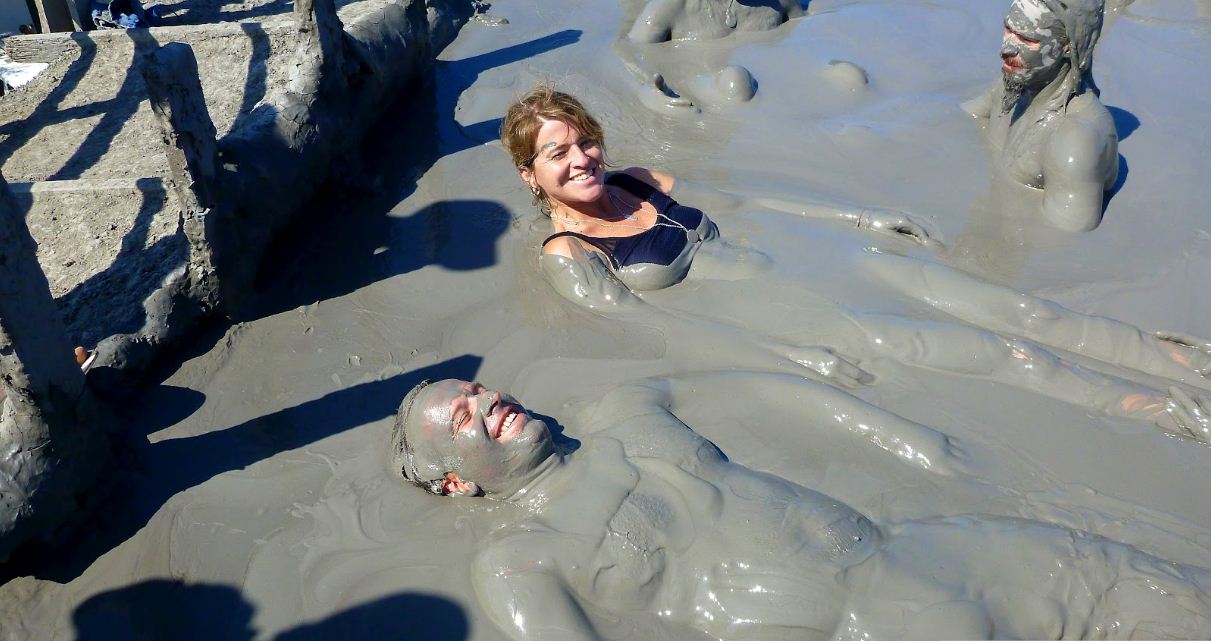
Things to do in Pamukkale
- You can walk down barefooted in the waterfalls from the village. The place is crowded when the tour-buses arrive. No shoes are allowed on the travertines. If you don’t want to walk back to top, you can use the buses dropping off people back to top, which depart from near lower end of the travertines. You should wear a swimming suit. A lot of people bathe in the baths here.
- It is also worth making the effort to get to the remains of the ancient city of Aphrodisias—one of the best preserved Roman sites in southeastern Aegean. You can rent a van from Denizli to get there. Local bus companies will arrange bussing for 30-40 TL.
- Bathe in the mineral hot springs. This is an enclosed pool, with additional entrance fee of 32 TL as of September 2015, above waterfalls.
- Of moderate interest might be visiting Denizli. It’s a bit dull but there’s a lively market.
How to get to Pamukkale?
Frequent buses and minibuses make the 40 minute run between Denizli’s bus station and Pamukkale. Turkish Airlines (turkishairlines.com) and Pegasus (flypgs.com) both fly to Denizli’s Cardak airport from Istanbul. Rail buffs might be interested in the four times daily service between Izmir and Denizli, via Selcuk.
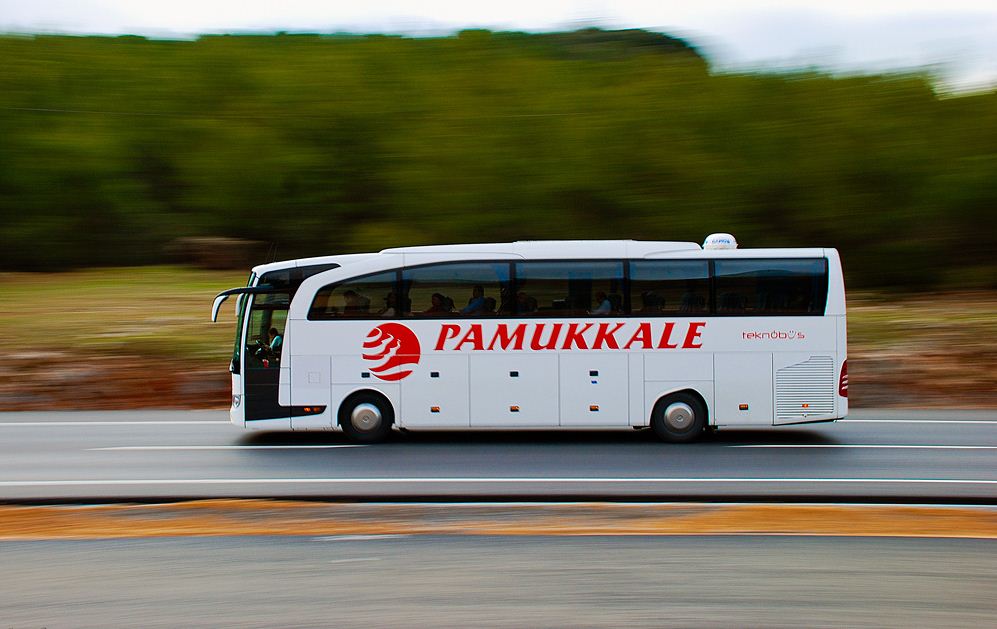
By bus
There are plenty of buses going from Istanbul to Denizli, it takes 9.5 hours – 12 hours and costs about 50TL. E.g. Pamukkale Turizm have 10 buses per day doing that route, probably several other companies too. A 20-minute bus ride to Pamukkale from the town of Denizli, with buses running every 15 minutes.
Bus ticket from Istanbul to Pamukkale, There are overnight buses from istanbul to denizli everyday. the destination is very busy destination for the bus travel to Pamukkale. Bus ride takes about 12 hours. Pamukkale bus company and metro bus company has travel link to Pamukkale from Istanbul and buses go to Denizli then you need to change minibus to Pamukkale about 30 min drive.
For travelling from Istanbul to Pamukkale you need to Catch overnight bus to Denizli. There are 2 Compasnies running regularly buses to Denizli Pamukkale Tourism and Metro Tourism. Mainly buses are busy and at least a week before if you make your booking will be more guarantie to find a seat on the buses.
By train
The Pamukkale Ekspresi is a daytime train that links Denizli (near Pamukkale) to the Istanbul High-Speed Train station at Eskişehir.
You can take the 06:45 am High-Speed Train from Istanbul (Pendik) to Eskişehir, arriving at 09:37 am, then change trains to the Pamukkale Ekspresi which departs Eskişehir at 10:00 am, stops at Kütahya (11:35 am) and Afyon (13:26/1:26 pm), and arrives in Denizli at 17:56 (5:56 pm).
From Denizli, the Pamukkale Ekspresi departs at 08:00 am, departs Afyon at 12:33 pm, and Kütahya at 14:38/2:38 pm. At Eskişehir it arrives at 16:06/4:06 pm, in time for the 16:41/4:41 pm High-Speed Train departure for Istanbul, arriving at 19:25/7:25 pm.
So…it takes nearly 12 hours to travel by train what could be traveled by bus in 11 hours, and by plane in one hour.
But consider this: Denizli’s Çardak Airport is 64 km (40 miles) east of the city, so you must allow several hours for the transfer from Denizli or Pamukkale to the airport, including security checks and check-in time; then the flight, baggage claim, getting to ground transportation, and at least an hour to travel from Istanbul’s Atatürk Airport to the city center, and probably two hours from Sabiha Gökçen Airport.
The train’s great advantages are comfort and a relaxing scenic ride through the fertile Aegean region.
Accommodation
You can find, check rates, reviews & availability for the hotels in Pamukkale on Agoda.com or Booking.com.































![10 best airports in Asia in 2016 [RANKED] kuala-lumpur-international-airport-best airports in asia in 2016 by skytrax ratings](https://livingnomads.com/wp-content/uploads/2016/08/29/kuala-lumpur-international-airport-best-airports-in-asia-in-2016-by-skytrax-ratings-218x150.jpg)








